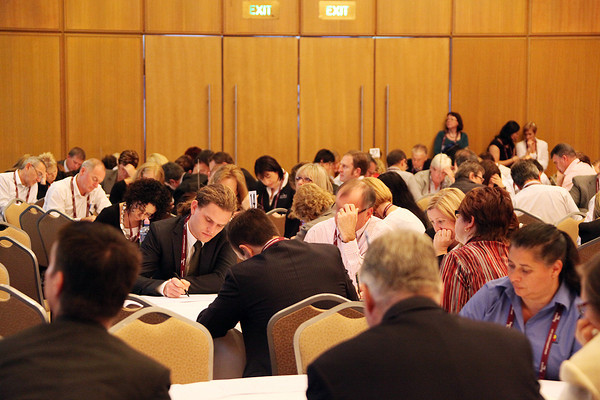What consumes most of your time at work?
A. For most managers, the answer is always the same — Meetings!
Yet in spite of their many criticisms of meetings (i.e. too many, too long, rarely produce an outcome) many managers and leaders adopt a hands off approach in the hope that their frustration with meetings will somehow correct itself.
This is a dumb thing to do.
The aim of this post therefore is to outline 9 principles that anyone can use to plan and run more engaged and effective meetings.
1. Meetings are a last resort
In the 1960′s there was a Japanese television show about a band of Phantom Agents (good guy Ninjas) who managed in every episode to fight and defeat the bad guys (not sure who they were) but in the opening sequence one of the agents is chastised by the leader for using a gun — ‘we are Phantom Agents, a gun is the last resort’.
It is a similar situation with meetings.
Getting expensive people together in a formal setting is both costly and time-consuming and should be considered as a last option after all other ways of collaborating and interacting have been considered e.g. email, phone call.
In my recent research with leaders of fast-growing businesses one leader mentioned that whenever someone wanted to meet with him he simply rang them up and asked what the issue was and whether they could sort it out on the phone rather than have a meeting.
In the majority of cases he told me they could do this.
This point is also important to consider at the end of a meeting — do not automatically call another meeting. Perhaps there are other ways of ensuring that momentum is maintained and follow up actions are completed.
2. Meetings are important
In a team-based, fast-moving, collaborative environment meetings are here to stay.
So managers rather than moaning about them should take them more seriously.
A well-run meeting can communicate, inspire, create and decide.
Meetings reflect the culture of the business and the values that the leaders espouse.
The starting point is for leaders to raise their expectations of meetings performance.
Why aren’t managers demanding that their meetings be world-class?
To achieve this, meetings have to have goals, be monitored, measured and reviewed just like any other organisational activity.
Why aim to deliver world-class products or customer service yet be ordinary in meetings (where you spend the bulk of your time).
Meetings are opportunities for leaders to role-model desired behaviour and to teach and develop others (so the next time you are late for a meeting consider what message it sends).
3. Running and planning a meeting is a key leadership skill.
Running a world-class meeting is a skill and like any skill can be developed with practice and focus.
Don’t believe me, then try and recall the names of any leaders or managers in your business that can run a results-oriented, energetic and engaged meeting. I suspect there will not be too many on your list.
There is a reason why this is the case.
Meetings involve 4 different types of Intelligences:
a. Rational e.g. plan, define, control etc.
b. Creative e.g. Brainstorming new ideas, solutions & questions
c. Emotional e.g. How you manage yourself; and
d. Social e.g. How you manage or interact with others
(see for example, Daniel Goleman: http://danielgoleman.info/ for more on the last two types of intelligences).
A truly effective meeting manager uses all 4 Intelligences and can harness the appropriate intelligences of all participants so that the goals of the meeting are reached and people feel motivated when they leave.
4. Meetings can be designed
Getting 2 or more people together for a specific purpose (my definition of a meeting) can be designed in much the same way as you can design a new product or service. You do not have to be caught in the 1 hour meeting straightjacket. There is an infinite array of design elements you can use so that no two meetings are ever the same. For example, you can vary:
– Who attends
– The venue
– The agenda
– The time of day
– The technology involved
– It can be a sit down, stand up even a walking meeting.
Designing a meeting requires imagination. There is no reason why participants should ever be bored and we know that the more engaged the people are in a meeting the better the outcome.
5. Hudson’s Law of Meetings
The next principle is an extension of Parkinson’s Law (not the British Interviewer). Cyril Parkinson in a tongue in cheek way suggested that‘work expands so as to fill the time available for its completion’ based on his experience in the British Civil Service in the 1950′s (see:http://en.wikipedia.org/wiki/Parkinson’s_Law).
Hudson’s Law states that ‘meetings expand to the time set for the meeting’. By this I mean that whatever the length of the meeting it always miraculously tends to take up the time allocated (and sometimes more) almost regardless of the objectives of the meeting. As the default meeting time is 1 hour — guess what? Most meetings are an hour.
But why are most meetings 1 hour?
If the truth be told, no-one really knows. Perhaps it is a carry-over of being paid by the hour but the real reason (I suspect) is that 1 hour is the default time on Microsoft Outlook. Hence we have a situation where the tools we use are dictating the way we work not the other way round.
The upshot of Hudson’s rule is that if you want to get more done in a shorter time then reduce the length of the meeting.
In a division of a major company we made the default time 45 minutes.
This 25% saving in time across every meeting was a profound shift and employees reported that they achieved the same amount, they had more time to prepare and meetings actually started on time.
6. In planning a meeting think why, what then who.
The most important question in calling and planning a meetings iswhy the meeting is being called.
Every meeting should have a purpose e.g. The reason I am calling a meeting is to make a decision whether to employ a new graduate this year.
The next question is ‘what’ would you like to accomplish at the meeting (i.e. the goals or desired outcomes). For example, one of the key objectives of this meeting is to develop an action plan to announce a price increase within the next 4 weeks.
It is vital to have a clear purpose and set of objectives because it will determine who should attend and who does not need to, what preparation takes place, where and when the meeting might be held and how long it should be e.g. a brainstorming type meeting for a kid’s product could be held at a McDonalds Outlet.
7. ‘Freedom within limits’ enables creativity to emerge
The Golden Rule is that the why, what and who come before creating an agenda (which is the How).
The why, and what are the ‘ends’ and the how is the ‘means’ (not the reverse).
Many managers make the mistake of sending out an agenda with a fixed list of items and timings.
There are two problems with this; the first is that often they have not clarified the desired outcomes they want to achieve and secondly, they do not allow any freedom to move if an interesting idea or novel solution or discussion emerges.
An agenda is just a suggested plan (and I am all for developing a loose : tight one) but that is all it is.
The aim in any meeting is to achieve the objectives not to satisfy a pre-set agenda (although hopefully the two are aligned).
I have been in many meetings where an amazing discussion is taking place but has run over slightly according to the agenda so the conversation has been cut short. This means that everyone in the meeting has to reconvene and try and re-capture the magic of the previous discussion.
Remember with the agenda, less is more. It is better to tackle a few items really well and finish early then try and take on too much leaving everyone frustrated.
8. Do the simple things first.
This is a key Speed Thinking Principle. With this way of thinking it is important just to start, it does not matter where but just to start.
As Seth Godin suggests, “the challenge, it turns out, isn’t in perfecting your ability to know when to start and when to stand by. The challenge is getting into the habit of starting.” (Poke the Box, 2011, Page 5).
My suggestion is to start any meeting with the quick and easy items. Make a decision, solve a simple problem, get an ok to move ahead quickly — this will create confidence, energy and momentum in the meeting and free up time to tackle the bigger issues.
So often what happens is that the groups get bogged down in the bigger issues with little forward movement (or trust) and when this happens these issues do not get resolved and frustratingly neither do the smaller ones.
9. It’s ok to say No!
This is perhaps the most important principle of all. Many managers have been brought up to believe that attending every meeting they are invited to is a sign of corporate commitment. Actually it is quite the opposite.
It is a sign that a manager cannot prioritize and has confused activity with achievement. It is the results that counts not the number of meetings.
The burden of proof now lies with the champion of a meeting to demonstrate why a person should attend rather than just assume they will turn up.
The very minimum a person should expect is that the purpose (why) and the objectives of a meeting (the what) should be offered as an invitation to attend which (like any invitation) can be accepted or rejected.
In Summary:
Managers and leaders are time-poor and most want a better work-life balance.
This means that the very activity that consumes most of their time should be the one they spend most of their efforts.
To become more productive every manager and leader has to learn to run more effective meetings.
In fact, it should be a compulsory course for any new employee or manager that has just been promoted.
As a final comment why not try using our new Digital Blitz Tool which can help you and your team to solve problems quicker and ensure that everyone contributes.

